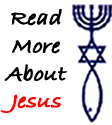






306: The Roman Catholic Church’s Synod of Elvira banned marriages and all contact between Christians and Jews.
315: Constantine made Christianity the "state" religion. His Edict of Milan extended religious tolerance to Christians, but Jews lost many of their rights. The edict also declared that Jews were no longer allowed to live in Jerusalem.
325: The Council of Nicea separated the celebration of Easter from the Jewish Passover. Its subsequent edict stated, "For it is unbecoming beyond measure that on this holiest of festivals we should follow the customs of the Jews. Henceforth let us have nothing in common with this odious people…
"We ought not, therefore, to have anything in common with the Jews…our worship follows a …more convenient course… we desire, dearest brethren to separate ourselves from the detestable company of the Jews… How, then, could we follow these Jews, who are almost certainly blinded."
337: Emperor Constantius made the marriage of a Jewish man to a Christian punishable by death.
339: Converting to Judaism became a criminal offense.
343-381: The Laodicean Synod approved Cannon XXXVIII: "It is not lawful [for Christians] to receive unleavened bread from the Jews, nor to be partakers of their impiety."
367-376: St. Hilary of Poitiers referred to Jews as a perverse people whom God has cursed forever. St. Ephroem refers to synagogues as brothels.
379-395: Emperor Theodosius the Great permitted the destruction of synagogues if it served a "religious purpose." Christianity became the state religion of the Roman Empire at this time.
380: The Bishop of Milan was responsible for the burning of a synagogue; he referred to it as "an act to pleasing God."
415: St. Augustine wrote, "The true image of the Hebrew is Judas Iscariot, who sells the Lord for silver. The Jew can never understand the Scriptures and forever will bear the guilt for the death of Jesus."
418: St. Jerome, who created the Vulgate translation of the Bible, wrote of a synagogue: "If you call it a brothel, a den of vice, the devil’s refuge, Satan’s
fortress, a place to deprave the soul, an abyss of every conceivable disaster or whatever you will, you are saying less than it deserves."
489-519: Christian mobs destroyed the synagogues in Antioch, Daphne (near Antioch), and Ravenna.
535: The Synod of Claremont decreed that Jews could not hold public office or have authority over Christians.
538: The Third and Fourth Councils of Orleans prohibited Jews from appearing in public during the Easter season. Canon XXX decreed that "from the Thursday before Easter for four days, Jews may not appear in the company of Christians." Marriages between Christians and Jews were prohibited.
561: The Bishop of Uzes expelled Jews from his diocese in France.
613: Jews were given the options of either leaving Spain or converting to Christianity. Jewish children over six years of age were taken from their parents and given a Christian education.
692: Canon II of the Quinisext Council stated: "Let no one in the priestly order nor and layman eat the unleavened bread of the Jews, nor have and familiar intercourse with them, nor summon them in illness, nor receive medicine from them, nor bathe with them; but if anyone shall take in hand to do so, if he is a cleric, let him be deposed, but if a layman, let him be cut off."
694: At the Seventeenth Council of Toledo, Spain defined Jews as the serfs of the prince. This was based, in part, on the beliefs of Chrysostom, Origen, Jerome, and other Church Fathers, i.e. that God punished the Jews with perpetual slavery because of their responsibility for the execution of Jesus.
722: Leo III outlawed Judaism; Jews were baptized against their will.
1050: The Synod of Narbonne prohibited Christians from living in the homes of Jews.
1078: Pope Gregory VII decreed that Jews could not hold office or be superiors to Christians.
1078: The Synod of Gerona forced Jews to pay church taxes.
1096: The First Crusade was launched. As the soldiers passed through Europe on the way to the Holy Land, large numbers of Jews were challenged: "Christ-killers, embrace the Cross or die!" In the Rhine Valley alone, 12,000 Jews were killed in the First Crusade.
1099: The Crusaders forced all of the Jews of Jerusalem into a central synagogue and set it on fire. Those who tried to escape were forced back into the burning building.
1205: Pope Innocent III wrote to the archbishops of Sens and Paris that "the Jews, by their own guilt, are consigned to perpetual servitude because they crucified the Lord…As slaves rejected by God, in whose death they wickedly conspire, they shall by the effect of this very action, recognize themselves as the slaves of those whom Christ’s death set free…"
1227: The Synod of Narbonne required Jews to wear an oval badge, a requirement re instituted during the 1930’s by Hitler, who changed the oval badge to a Star of David.
1233: The Medieval Inquisition began. Later in 1252, Pope Innocent IV authorized the use of torture by the Inquisitors.
1236: Pope Gregory ordered that church leaders in England, France, Portugal, and Spain confiscate Jewish books on the first Saturday of Lent. In 1242, thousands of such books were publicly burned in Paris.
1259: A synod of the archdiocese in Mainz (Germany) ordered Jews to wear yellow badges.
1267: The Synod of Vienna ordered Jews to wear horned hats. Thomas Aquinas said that Jews should live in perpetual servitude.
1347: Rumors circulated that Satan was protecting Jews from the Black Death and that they were paying back the devil by poisoning wells used by Christians. (A smaller percentage of Jews than Christians caught the disease; Jewish sanitary and dietary laws probably had protected them.) The solution was to torture, murder, and burn the Jews.
In Bavaria, 12,000 Jews perished; in the small town of Erfurt, 3,000; in Rue Brulee, 2,000 Jews. Near Tours, a large trench was dug and filled with blazing wood; in a single day, 160 Jews were burned. In Strausberg, 2,000 Jews were burned; in Maintz, 6,000 were killed; in Worms. 400.
1431: The Council of Basel forbade Jews to go to universities, prohibited them from acting as agents in the conclusion of contracts between Christians, and required that they attend church sermons.
1453: Capistrano, a Franciscan monk, persuaded the King of Poland to terminate all Jewish civil rights.
1478: The Spanish Inquisition was established by Ferdinand and Isabella of Spain to detect insincere conversations. Laws were passed that prohibited the descendents of Jews from attending university, joining religious orders, holding public office, or entering any of a long list of professions.
1492: Jews were given the choice of being baptized as Christians or banished from Spain. Three hundred thousand left Spain penniless.
1497: Jews were banished from Portugal; twenty thousand left the country rather than be baptized as Christians.
1555: A Roman Catholic Papal bull, "Cum Nimis Absurdum," required Jews to wear badges and live in ghettos. They were not allowed to own property outside the ghetto.
Articles of Interest Include:
 Read more about Anti-Semitism
Read more about Anti-Semitism
Read about Messiah In The Jewish Holidays
Read about The Messiah
Source: Messianic Perspectives May-June 2003, Published by the Christian Jew Foundation.